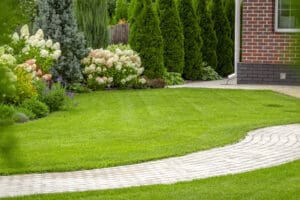As summer winds down here in Michigan, and we start turning our attention to pumpkin patches, cornfields, and hayrides, we should also turn our attention to fall lawn care. Michigan summers can be harsh on even the healthiest lawns, and this past summer was a hot one! Excessive heat, drought, and heavy foot traffic can cause stress, damage, and fatigue. With most of us created our own staycations at home this summer, you can bet your grass has seen its share of overuse and heavy foot traffic. All of this wear and tear can cause soil compaction.
Summary Points
ToggleWhat is Soil Compaction?
 Compacted soil is essentially a build-up of thatch, or layer of grass clippings and organic matter that form a barrier at the base of your turf. It reduces the rate of both water infiltration and drainage preventing nutrients and water from getting to and from your grassroots. This will cause your grass to become malnourished and dehydrated. Weakening over time, it will die.
Compacted soil is essentially a build-up of thatch, or layer of grass clippings and organic matter that form a barrier at the base of your turf. It reduces the rate of both water infiltration and drainage preventing nutrients and water from getting to and from your grassroots. This will cause your grass to become malnourished and dehydrated. Weakening over time, it will die.
Signs Your Soil is Compacted
- Spongy grass
- Water runs off or pools in areas of your yard
- Bare or patchy areas of grass
- Stunted growth of plants
- Hard soil: Test your soil by sticking a screwdriver into the ground. If it’s dry and does not easily penetrate, your soil is probably compacted.
The best way to combat compacted soil is through a process called core aeration.
What is Core Aeration?
Core aeration uses a machine to perforate small holes in your soil, pulling up hundreds of tiny plugs to redistribute the turf across your lawn. Doing this allows the much-needed water and nutrients to penetrate the roots of your grass. This can be done by poking holes in your yard with special boots or a sharp stick. For much better results, core aeration provided by a professional lawn care company such as Top Lawn, is highly recommended.
What Are the Benefits of Lawn Aeration?
 Breaks down the thatch build-up that is blocking your roots from absorbing the essential water and nutrients
Breaks down the thatch build-up that is blocking your roots from absorbing the essential water and nutrients
- Reduces soil compaction
- Promotes stronger roots
- Improves water and fertilizer intake
- Eliminates water runoff and puddling
- Improves your lawn’s resistance to drought
When is the Best Time to Aerate?
Aerating a lawn should be done once a year or, at least, once every other year. It should only be done during the growing season for your grass, as this will allow your lawn to recover quickly after the service. Here in Michigan, we have mostly cool-season grasses such as Kentucky bluegrass, Ryegrass, and Fescue with a growing season in the spring and fall. This means that late summer or early fall is the best time to aerate your lawn. At Top Lawn, we offer spring and fall aeration to coincide with the active growth period for your lawn.
Top Lawn Provides State of the Art Aeration Process
Top Lawn’s state of the art aeration process consists of core aerators that are self-propelled machines with rotating hollow tines that push into the soil. Our highly effective method will give your lawn the boost that it needs to return to its healthy state. Call us today at 248-956-6022 or contact us online to learn more about our aeration process.
Want more tips and ideas? Check out our blog! Or get to know us on a more intimate level by liking us on Facebook and following us on Twitter.





